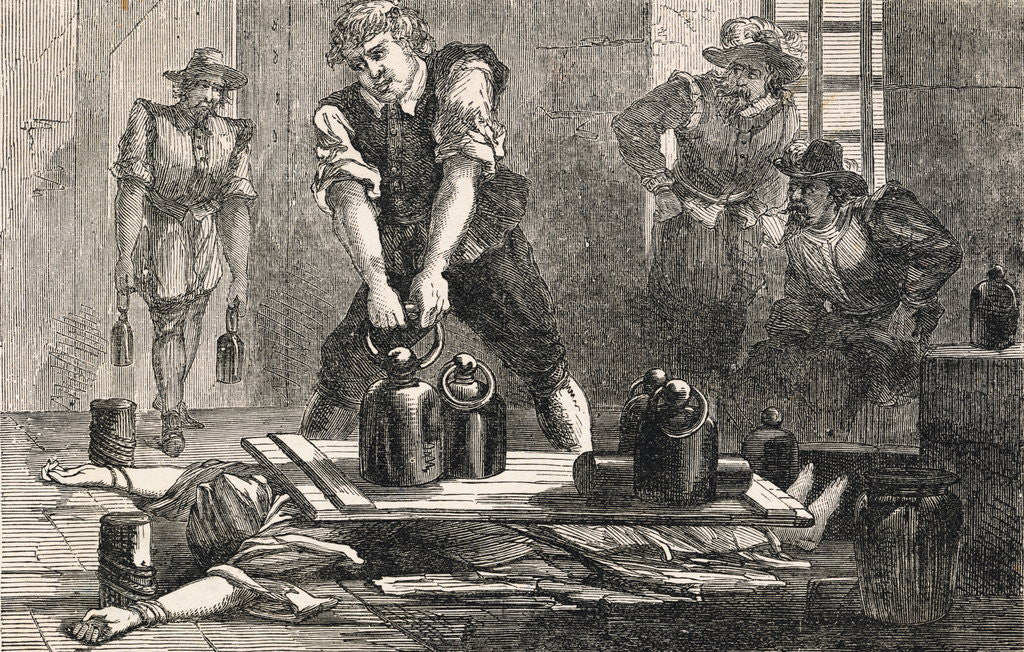
The Pressing of Margaret Clitherow, York, 1586
Witnesses reported hearing her ribs crack—audibly, like green wood splitting. Blood began to run from her nose and mouth. Still, she continued to pray aloud: “Jesu, Jesu, Jesu, have mercy upon me.
This is the harrowing death of Margaret Clitherow.
March 1586
Margaret Clitherow was the wife of a butcher. She lived on the Shambles in York—a narrow street that still exists today, where the overhanging timber houses nearly touch overhead and the gutters once ran with blood from the slaughterhouses. She had three children, a business to run, and a faith that had become illegal.
By March 1586, she had been arrested multiple times for recusancy—refusing to attend services at the Church of England.
But this time was different. Margaret had been caught sheltering Catholic priests, men who moved in secret through a network of safe houses across the North. Under Elizabeth I’s 1585 Act Against Jesuits and Seminary Priests, this was high treason.

Margaret Had Tried To Protect Everyone
When brought before the assizes, she was offered a choice: plead guilty or not guilty, stand trial, and let the law decide.
She refused to plead at all.
This was not stubbornness. A trial would compel her three children to testify against her. English law offered them no protection. They would be forced to speak, or lie under oath. She would not allow it.
For that silence, she was sentenced to peine forte et dure: pressing to death beneath weights until she entered a plea or died.
25 March 1586 — The Tollbooth, Ouse Bridge
The chamber was narrow, stone-floored, and cold. Margaret was made to lie flat on her back. Her arms were stretched out and tied to posts driven into the ground. Beneath her spine, and some sources say between her shoulder blades, the executioner placed a sharp stone, roughly the size of a fist. Its purpose was to hasten death by concentrating the crushing force.
A heavy wooden door, taken from its hinges, was laid across her body.
Then the weights were brought.
Stones. Iron bars. Rubble. Loaded onto the door piece by piece. The intention was straightforward: the increasing pressure would either force her to speak or stop her breathing. Most pressed prisoners lasted minutes.
Margaret Clitherow lasted longer.

What Went Wrong
Witnesses reported hearing her ribs crack—audibly, like green wood splitting. Blood began to run from her nose and mouth. Still, she continued to pray aloud: “Jesu, Jesu, Jesu, have mercy upon me.”
But the weight did not crush her quickly. The execution, which should have brought swift suffocation, became protracted. The load—estimated at 700 to 800 pounds—bore down upon her, breaking bones, collapsing her chest.
Contemporary accounts state it took fifteen minutes before she stopped praying. Fifteen minutes of conscious agony beneath half a ton of stone and iron.
By the time her body was finally still, her ribcage was shattered, her torso visibly flattened. The stone’s imprint was visible through her torn clothing.
The Aftermath
She was buried quickly, in an unmarked grave. Some say her hands were still folded around a crucifix.
The sheriff of York reportedly refused food for days afterwards. He told his wife that the death had been “not of man, but of judgement“—whether he meant divine or his own guilty conscience is unclear.
Margaret Clitherow’s house on the Shambles still stands. Visitors leave flowers beneath the window where she was first arrested. She was canonised in 1970, but in 1586, she was simply a woman who would not break, even when her body did.
The Horror
The true horror of pressing lies not in its brutality, but in its precision. It was designed to extract compliance through escalating suffering. The condemned could stop it at any moment—by speaking.
Margaret Clitherow never did.
What should have been an execution became something else: a mechanical failure that turned death into drawn-out mutilation. The stone that was meant to speed her end became the instrument of its delay. The door that should have silenced her prayers did not, for long minutes, succeed.
She died as she had lived: unyielding.
Centuries later, Margaret Clitherow was canonised as Saint Margaret Clitherow by Pope Paul VI in 1970, honoured among the Forty Martyrs of England and Wales for her courage and faith. Her feast day is now kept on 26 March, when Catholics remember the woman who chose silence over betrayal. Her shrine still stands on The Shambles in York, where candles burn quietly for the saint they still call the Pearl of York.
Further Reading
St. Margaret Clitherow by Margaret Monro — a good introductory biography of Saint Margaret Clitherow. Amazon UK
Margaret Clitherow of York by John Rayne-Davis — a detailed study with strong historical context. Amazon UK
If you love what we do, then help us keep history alive by supporting us on Ko-Fi. You will also receive special insights into our stories and what we think of them there.







